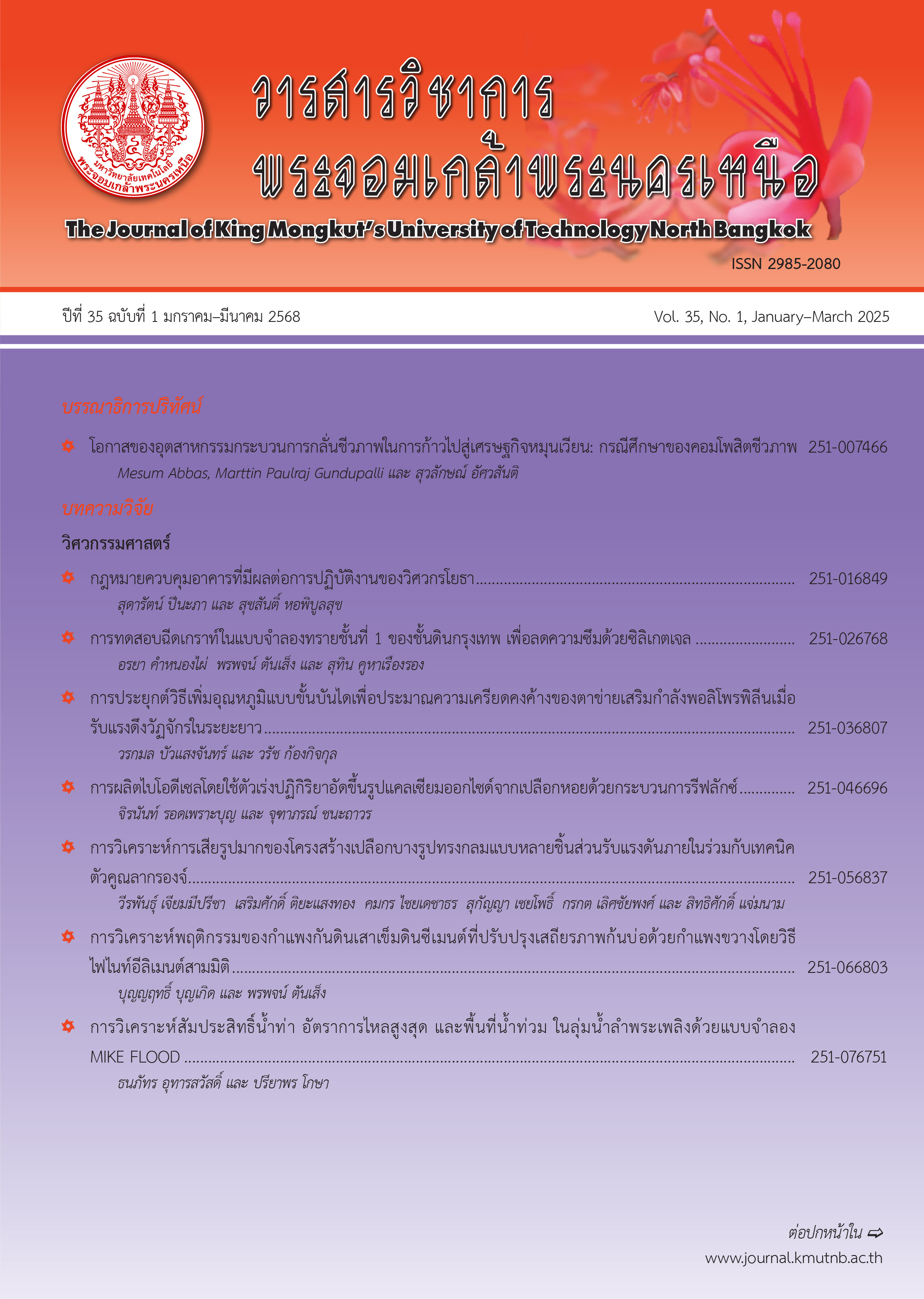การศึกษาปัจจัยของการตัดด้วยน้ำแรงดันสูงที่ส่งผลต่อคุณภาพการตัดแผ่นปูพื้นยางพารา
Main Article Content
บทคัดย่อ
งานวิจัยนี้มีวัตถุประสงค์เพื่อศึกษาปัจจัยของการตัดด้วยน้ำแรงดันสูงที่ส่งผลต่อคุณภาพการตัดแผ่นปูพื้นยางพารา เพื่อพัฒนาเป็นแผ่นจิกซอว์ยางพารา โดยพิจารณาปัจจัยตัวแปรการตัด ประกอบด้วย อัตราการไหลของผงตัด ระยะห่างระหว่างหัวตัดกับชิ้นงาน แรงดันน้ำ และความเร็วในการตัด ที่ส่งผลต่อคุณภาพการตัดชิ้นงาน คือ ความหยาบผิวของรอยตัด ความกว้างของรอยตัด และมุมเอียงของรอยตัด โดยใช้การออกแบบการทดลองแฟกทอเรียลเต็มรูปที่ 3 ระดับ เพื่อหาเงื่อนไขการตัดที่เหมาะสมต่อคุณภาพชิ้นงาน เมื่อทำการวิเคราะห์ผลการทดลองทางสถิติโดยกำหนดระดับนัยสำคัญที่ 0.05 พบว่า ปัจจัยอัตราการไหลของผงตัด ระยะห่างระหว่างหัวตัดกับชิ้นงาน แรงดันน้ำ และความเร็วในการตัดมีผลต่อคุณภาพการตัด เงื่อนไขการตัดแผ่นจิกซอว์ยางพารา ขนาดความหนา 7 มิลลิเมตร และความแข็ง (Shore A) 50–90 ที่เหมาะสม คือ อัตราการไหลของผงตัด 350 กรัมต่อนาที ระยะห่างระหว่างหัวตัดกับชิ้นงาน 2 มิลลิเมตร แรงดันน้ำ 300 เมกะปาสคาล และความเร็วในการตัด 2,000 มิลลิเมตรต่อนาที เมื่อนำปัจจัยที่เหมาะสมดังกล่าว ไปประยุกต์ใช้ในกระบวนการตัดจริงสามารถตัดชิ้นงานได้จริงโดยใช้เวลาตัดน้อยเพียงประมาณ 3 นาทีต่อชิ้นงานขนาด 10×10 เซนติเมตร คุณภาพรอยตัดความหยาบผิวเฉลี่ยด้านบนและด้านล่างอยู่ที่ 3.15 ไมโครเมตร และ 3.37 ไมโครเมตร ความกว้างเฉลี่ยด้านบนและด้านล่างอยู่ที่ 1.35 มิลลิเมตร และ 1.28 มิลลิเมตร และมุมเอียงรอยตัดเฉลี่ยอยู่ที่ 1.83 องศา ตามลำดับ ซึ่งผลการวิจัยเป็นประโยชน์ต่อผู้ประกอบการที่ต้องการเพิ่มมูลค่าแผ่นปูพื้นยางพาราเป็นแผ่นจิกซอว์ยางพารา โดยกระบวนการตัดหลังการขึ้นรูป
Article Details

อนุญาตภายใต้เงื่อนไข Creative Commons Attribution-NonCommercial-NoDerivatives 4.0 International License.
บทความที่ลงตีพิมพ์เป็นข้อคิดเห็นของผู้เขียนเท่านั้น
ผู้เขียนจะต้องเป็นผู้รับผิดชอบต่อผลทางกฎหมายใดๆ ที่อาจเกิดขึ้นจากบทความนั้น
เอกสารอ้างอิง
Ministry of Commerce. (2023, January 10). Thailand's Natural Rubber Export Volume, [Online]. Available:https://tradereport.moc. go.th/Report/Default.aspx?Report=MenucomT opNCountry&Option=1&Lang=Th&ImExType=1
K. Phimchat, P. Pitayachaval, and N. Thammacho, “A surface effect of ceramic cutting using abrasive waterjet,” presented at the 10th South East Asian Technical University Consortium (SEATUC) Symposium, Shibauralinstitute of Technology, Tokyo, Japan, Feb. 22 – 24, 2016.
Industrial Product Standards for Rubber mats, TIS 2377-2551, 2008 (inThai).
Water Cutting Machine. (2022, May 12). Abrasive Waterjet Cutting. [Online]. Available: http://waterjetcutting.blogspot.com/2010/09/ abrasive-waterjet cutting.html
P. S. Na Ayutthaya and P. Luangpaiboon, Design and analysis of experiments. Bangkok: Top Publishing, 2008 (in Thai).
R. Prabu, K. M. Kumar, T. Maridurai, and R. Selvam, “Optimization of machining parameters during machining of austenitic stainless steel 304 in abrasive water jet machine,” International Journal of Mechanical and Production Engineering Research and Development (IJMPERD), vol. 8 no. 3, pp. 1191–1201, 2018.
M. Monno and C. Ravasio, “the effect of pressure on the surfaces generated by waterjet: Preliminary analysis,” International Journal of Machine Tools and Manufacture, vol. 45, no. 3, pp. 335–363, 2005.
N. P. Singh, D. S. Srinivasu, and N. R. Babu, “Modelling of abrasive waterjet kerf in a doublelayered structure,” Journal of Manufacturing Processes, vol. 69, pp. 514–531, 2021.
V. Chenrayan, C. Manivannan, K. Shahapurkar, G. A. Zewdu, N. Maniselvam, I. M. Alarifi, K. Alblalaihid, V. Tirth, and A. Algahtani, “An experimental and empirical assessment of machining damage of hybrid glass-carbon FRP composite during abrasive water jet machining,” Journal of Materials Research and Technology, vol. 19, pp. 1148–1161, 2022.
M. Sukkee, T. Wiwatcharoen, and S. Mathitopanum, “The influence of water pressure affect cutting for the grade aluminum A1100 in the forming process with high pressure water,” Journal of Rajamangala University of Technology Isan, vol. 8, no. 3, pp. 146–158, 2015 (in Thai).
Jiangsu Sunrise Intelligent Equipment Co., Ltd. (2020, January 23). Sunrise Waterjet Cutting Machine, [Online]. Available: http://f02.s.alicdn. com/kf/HTB1fpyKGXXXXXaWXVXX.PRXFXXX0.pdf
Mitutoyo America Corporation. (2020, January 18). SURFTEST SJ-310 SERI, [Online]. Available:https:// www.mitutoyo.com/webfoo/wp-content/ uploads/2141-SJ-310.pdf
Mitutoyo America Corporation. (2020, January 18). PJ-A3000 PROFILE PROJECTOR, [Online]. Available:https://www.mitutoyo.com/webfoo/ wp-content/uploads/2021_PJ-A3000.pdf
M. Nanduri, D. G. Taggart, and T. J. Kim, “The effects of system and Geometric parameters on abrasive water jet nozzle wear,” International Journal of Machine Tools and Manufacture, vol. 42, no. 5, pp. 615–625, 2002.
F. L. Chen and E. Siores, “The effect of cutting jet variation on striation formation in abrasive water jet cutting,” International Journal of Machine Tools and Manufacture, vol. 41, no. 10, pp. 1479–1486, 2001.
P. Gudimetla, J. Wang, and W. Wong, “Kerf formation analysis in the abrasive waterjet cutting of industrial ceramics,” Journal of Materials Processing Technology, vol. 128, no. 1–3, pp. 123–129, October 2002.
J. Wang and D. M. Guo, “The cutting performance in multipass abrasive waterjet machining of industrial ceramics,” Journal of Materials Processing Technology, vol. 133, no. 3, pp. 371–377, 2003.
M. Sukkee, “Investigation of the cutting condition of aluminum alloy on abrasive water jets process,” M.S. thesis, Department of Manufacturing Engineering, Faculty of Engineering, Rajamangala University of Technology Thanyaburi, 2013 (in Thai).
International Organization for Standardization for Geometrical Product Specifications (GPS) of surface texture, ISO 1302, 2002.
MRP ENGINEERING CO.,LTD. (2022, March 23). Surface roughness [Online]. Available: http:// www.mrp.co.th/files/journal/mrp_journal_4.pdf
W. Sayorwan, A. Yantarapakorn, S. Jirasintipok, and A. Sangkum, “The development of jigsaw puzzles image of english vocabulary for special need Childrenat Boriboonsilsuksa School, Bangkok province,” Journal of Nursing and Education, vol. 10, no. 2, pp. 46–57, 2017 (in Thai).

